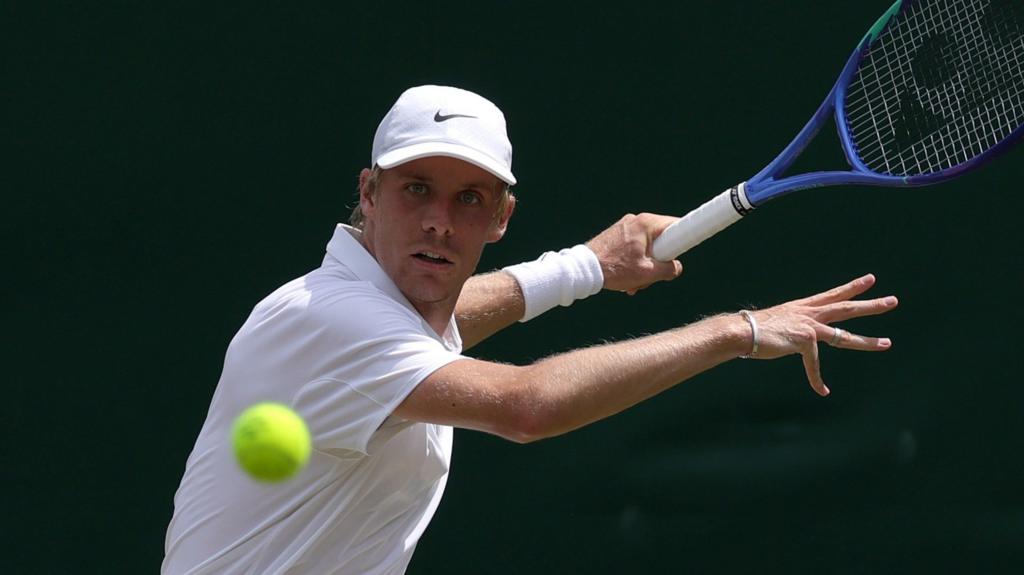Denis Shapovalov has joined the chorus of players expressing concerns about the court surface at Wimbledon.
While high temperatures have posed a challenge for competitors at Wimbledon, some players are also voicing concerns about the grass surface itself.
Several players participating in this week’s Grand Slam have noted inconsistencies in ball bounce, with one player likening the surface to clay, which is typically much slower than grass.
The tournament’s opening days have been marked by unusually high temperatures, with Monday setting a record for the warmest opening day at 32.3C. Tuesday saw temperatures rise further to 33.4C, before rain arrived on Wednesday morning.
Wimbledon’s head groundsman, Neil Stubley, acknowledged that the heat has contributed to slower court conditions but disputed claims regarding inconsistencies in ball bounce.
“We prioritize consistency in our ball bounce and ball speed,” he told BBC Sport. “We consistently strive to ensure this remains uniform.”
“The ball may appear slightly slower due to the [grass] leaf drying out, causing the ball to grip the leaf more.
“While this difference may be imperceptible to most, elite athletes can detect these nuances, allowing them a fraction of a second to adapt.
“We are confident in the consistency and overall condition of the courts.”
Defending women’s champion Barbora Krejcikova also shared her observations on the surface after her opening match victory against Alexandra Eala on Tuesday.
“There’s not enough water, and it gets really, really yellow, very, very fast,” she said.
“I think with the heat, yes, the grass is more like stopping. The game is just different [to] what you are normally used to.”
Denis Shapovalov, the number 27 seed from Canada, was eliminated in the first round by Argentina’s Mariano Navone.
Shapovalov was broken six times, marking his earliest exit from the tournament since 2019.
Following his defeat, he stated, “The balls are the worst, the grass tour has turned into a joke.”
“This isn’t grass any more, the court is slower than a clay one. It’s not even grass.”
Two-time champion Petra Kvitova also commented on the changes she has observed over the years.
“I’m not sure if it’s only grass,” she said. “Maybe it’s the balls, as well. Overall it’s getting slower.”
The first round saw eight top-10 seeded players exit the tournament – the highest number at a single Grand Slam in the Open era.
Among those eliminated was American third seed Jessica Pegula, who noted that the Wimbledon courts “felt different” but added, “That’s grass – they’re all kind of different. It’s a living surface, they’re not going to play the same.”
Former world number one Iga Swiatek of Poland believes the Wimbledon courts are playing slower, with the “ball bounced differently” in the heat, but anticipates changes.
“With the change of the weather we will have to adjust every day to the different conditions,” she said.
Wimbledon 2025
30 June to 13 July
Live across BBC TV, radio and online with extensive coverage on BBC iPlayer, Red Button, Connected TVs and mobile app.
Slower courts lead to longer rallies as players have more time on the ball.
It can therefore also lead to longer matches, which can be more physically draining for players.
Former doubles player Dom Inglot told BBC Sport that courts had been getting slower since 2001. Before that, you would see players hitting serve and volley predominantly rather than the long baseline rallies you more often see now.
He believes part of the change is down to Wimbledon wanting to make the courts more aesthetically appealing after years where the courts looked very worn by the second week, while also wanting to deliver a better spectacle for fans.
“The idea was Wimbledon had to compete with the great rallies you were seeing at the Australian Open, US Open, French Open,” he said.
“Serve and volley all the time was getting a bit mundane so they wanted more rallies and so there was discussion of do you change balls, do you change the court and I think they went with both.”
A slower surface means players need to adapt their tactics.
“It was ridiculous to think you could hit a kick serve that would jump off the surface like a kick works on clay or hard courts – that was not imaginable 10 years ago, now kick is working,” Inglot said.
“It used to be slice serves and flat serves but now you’re using kick serves because you’re starting to get the ball moving away from opponents.”
The grass on the courts at Wimbledon is cut every day
Since 2001, the Wimbledon grass is comprised of perennial pyegrass, which is said to have the durability and strength to withstand the wear of the modern game.
Groundsman Stubley said this type of grass has provided more consistency, adding: “Players are confident they know where the ball will bounce.
“In the old days of serve and volley, where the players didn’t realise what was going to happen, they didn’t want long rallies because they were not confident of where the ball would bounce.”
Wimbledon’s official website says a number of factors affect the speed of a court which include the compacting of the soil over time, as well as the weather before and during the event.
Warm and dry days should make a ball lighter and faster, while cold and damp days would make it seem heavier and slower.
The soil, it says, largely determines the bounce of ball, not the grass.
There have been no changes to the specification of the ball since 1995, when there was a very minimal alteration in compression.

